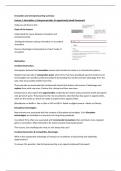Summary
Innovation and Entrepreneurship summary (all lectures and articles)
- Course
- Institution
Summary of all the lectures (4) and all the articles of the course. With slides of the lectures and the most important parts of each of the articles.
[Show more]



